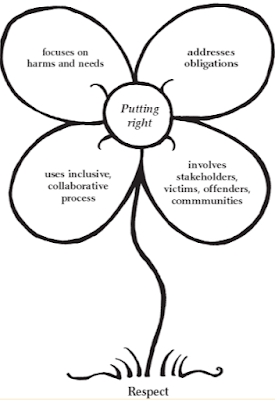- Overview
- Principles
- Practices
- Either/ Or
1. Overview of Restorative Justice
1970s start of Mennonite-led movement
1989 New Zealand made RJ the hub of juvenile justice system, Maori traditions
Navajo peacemaking courts, African customary law, Afghani practice of jirga
Restorative Justice is not
- NOT primarily about forgiveness/ reconciliation: no pressure
- NOT mediation: parties not on a level moral playing field, offenders required to admit responsibility
- NOT primarily designed to reduce recidivism OR minor offenses only
- NOT replacement for traditional justice system (elevate private, local dimension while traditional system deals with public, societal dimension)
Restorative Justice is:
- an invitation for dialogue & exploration
- take care of needs unmet in judicial system
- Victim:
- Info: why offense happened, what happened since
- Truth-telling: share stories for healing & reconstruct disrupted identity
- Empowerment: control over one's body, dreams, decisions
- Restitution/ vindication
- Offender: Punishment is not real accountability.
- Accountability that: addresses the harms, encourage empathy & responsibility, transform shame
- Encouragement for personal transformation: healing of past harm, treatment of addictions/ problems, enhance capacities
- Integrate into community
- Temporary restraint
- Community
- Attention to their concerns as victims
- Opportunities to rebuild community
- Encouragement to take on improve members' welfare
Restorative Justice focuses on needs more than deserts (offenders deserve what).
2. Principles of Restorative Justice
Crime is a violation of people & relationships. vs Crime is a violation of the law & the state.
Who has been hurt? vs What laws have been broken?
Violations create obligations. vs Violations create guilt.
What are their needs? vs Who did it?
Central obligation is to address victim needs and enable offenders to take responsibility for reparing harms. vs Central focus is offenders getting what they deserve.
Whose obligations are these? vs What do they deserve?
Justice involves victims, offenders & community in an effort to put things right. vs Justice requires the state to determine blame (guilt) and impose pain (punishment).
Who has a stake in this situation?
What is the appropriate process to involve stakeholders in an effort to put things right?
All violence is an effort to achieve justice or undo injustice. - James Gilligan
- Focuses on harm (of victims & offenders): even when no offenders are identifiable/ apprehended
- Address harm: Forum for assigning needs, responsibilities, expectations
- Address causes: prevention together with reparation (support offenders)
- Harm results in obligation: of offender accountability (concrete & symbolic) & community & society
- Promotes engagement: stakeholders are given significant roles
- How: collaborative & inclusive processes, consensual outcomes
- Who: + micro-communities of care
Restorative justice requires, at minimum, that we address victims' harms and needs, hold offenders accountable to put right those harms, and involve victims, offenders and communities in this process.
Restorative justice is a process to involve, to the extent possible, those who have a stake in a specific offense and to collectively identify & address harms, needs, and obligations, in order to heal and put things as right as possible.
3. Restorative Practices
To resolve wrong: Acknowledge injustice/ wrong. Restore equity. Address future intentions. - Ron Classen
3 models (format)
- Victim - Offender Conferences: private meeting --> meeting --> signed restitution agreement
- Family Group Conferences:
- New Zealand Youth Justice Coordinator
- Family caucus for offender's family: discuss what to bring back to the victim
- Not just express facts & feelings to develop agreements, but also develop entire plan for offender (reparations, prevention, punishment)
- Circle
- More wide-ranging discussion
3 models (goals)
- Alternative/ diversionary
- Healing/ therapeutic
- Transitional (re-entry)
4. Restorative vs Retributive: A continuum
Conrad Brunk: both theories seek to vindicate through reciprocity (by evening the score)


Post a Comment